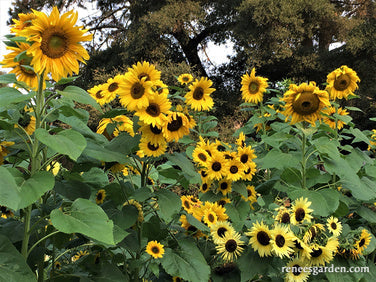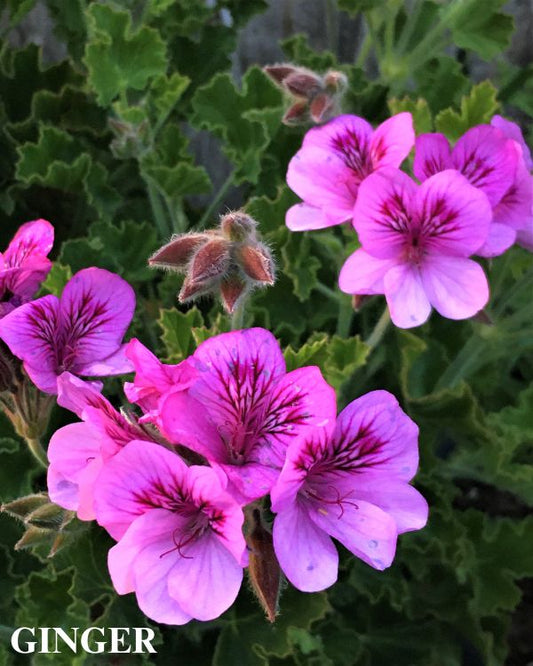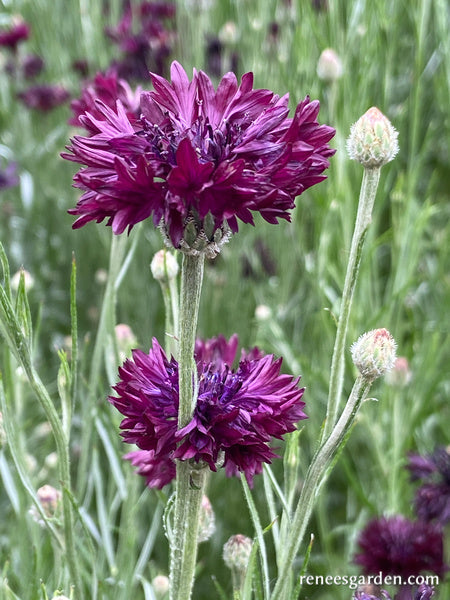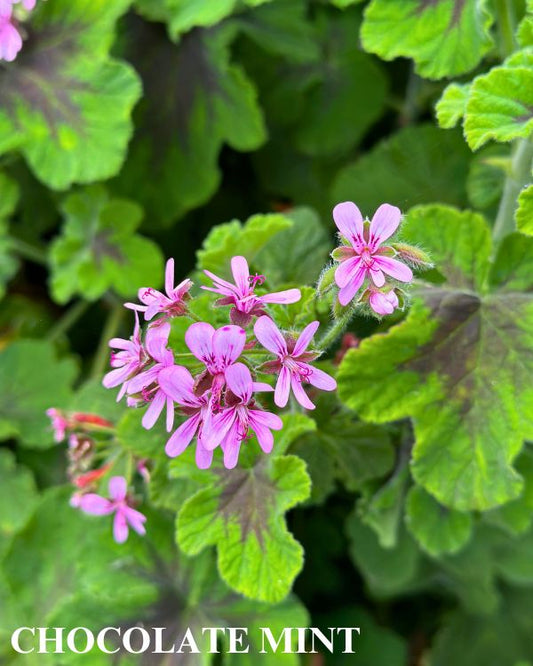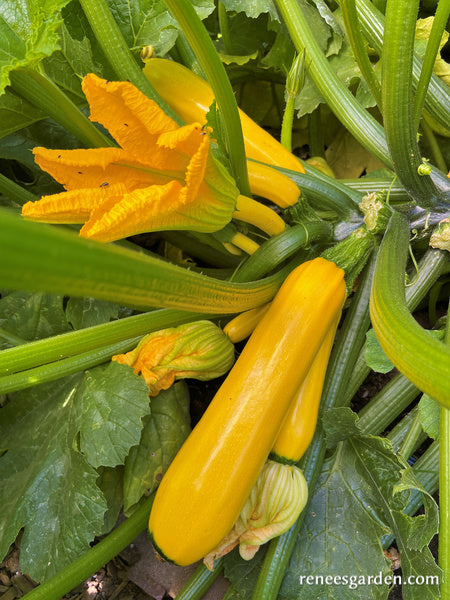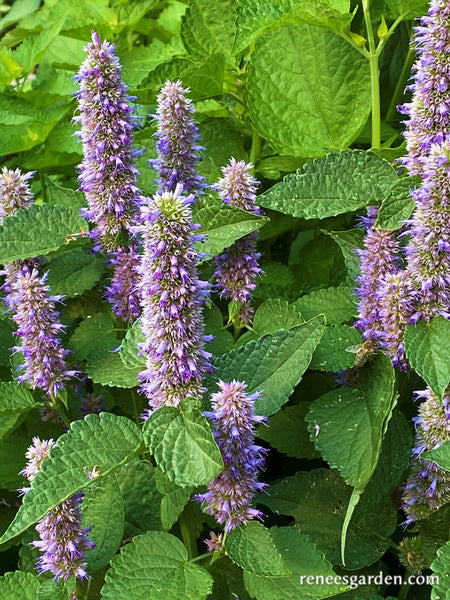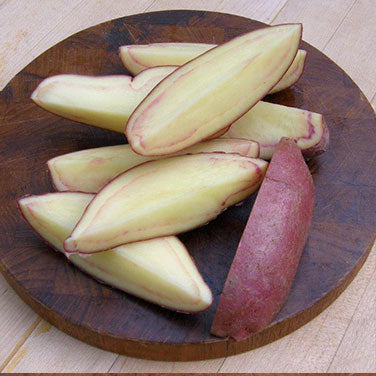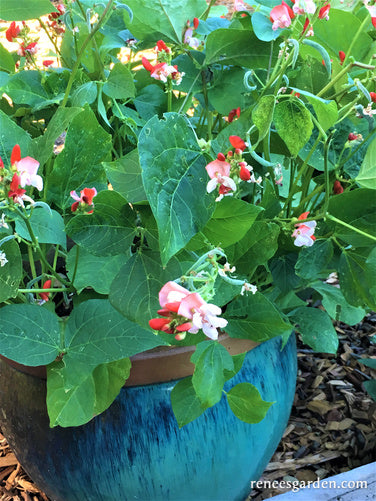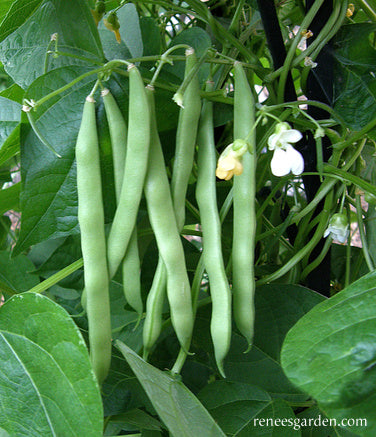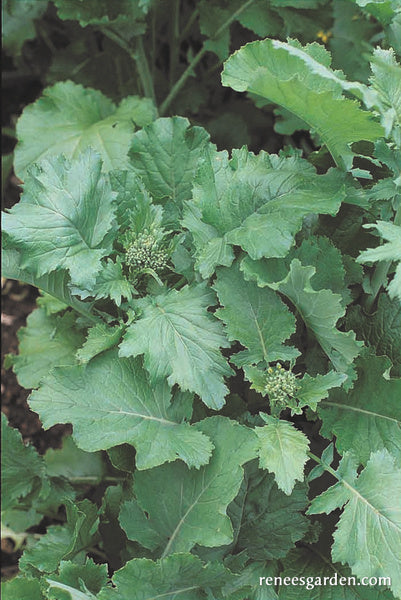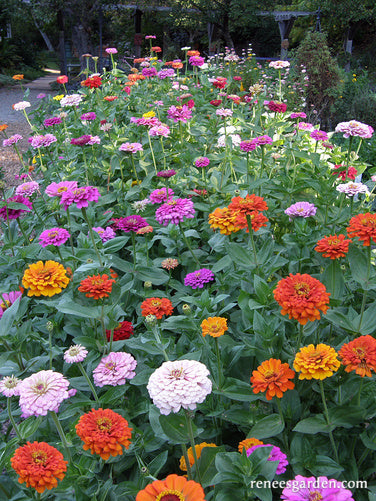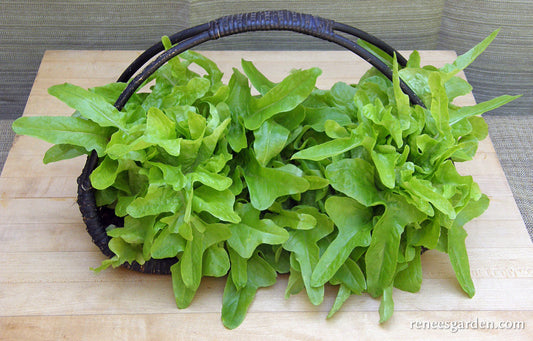Heirloom Selection
Heirloom Selections
-
Pollinator & Songbird Sunflowers Paintbox Bouquet
ANNUAL
Summer/fall bloom
Frost tenderEASIEST TO PLANT OUTDOORS
Plant in full sun in good garden soil when weather is warm and settled, all danger of frost is past and both days and nights are evenly in the 50°F (10°C) range. Poke seeds into well-worked soil about 1/2 in. deep, 4 to 5 in. apart. Press soil firmly over seeds and keep moist until seedlings emerge in 8 to 10 days. Important: when seedlings are well-established, thin them to a final spacing of 1 foot apart so plants can grow sturdy stalks and big flowers. Extra seedlings can be transplanted easily.
TO START EARLY INDOORS
Several weeks before last frost date, sow seeds ½ inch deep in individual pots of well-drained seed starting mix. Keep moist and provide a strong light source until seedlings are well established and ready to plant outside. Transplant carefully, disturbing the roots as little as possible. Space seedlings 1 foot apart so plants will have room to grow and mature.
GROWING NOTES
Growing these colorful sunflowers for pollinators and bouquets is both easy and rewarding. Make several sowings several weeks apart to have a succession of flowers in full bloom. Keep soil moist and well weeded and protect very young seedlings from birds with netting or plastic berry baskets, removing before plants get crowded.
Regular price $4.89Sale price $4.89Unit price / per -
Pollinator Sunflowers Lemon Queen
ANNUAL
Summer/fall bloom
Frost tenderEASIEST TO DIRECTLY PLANT OUTDOORS
Plant in full sun in good garden soil only when weather is warm and settled, all danger of frost is past and both days and nights are evenly in the 50°F (10°C) range. Poke individual seeds into well-worked soil about 1/2 in. deep, 4 to 5 in. apart. Press the soil firmly over the seeds and keep the seedbed evenly moist until seedlings emerge in 8 to 10 days.
Important: when the seedlings are well-established, carefully thin them to a final spacing of 1 foot apart; this way they will have enough room to develop sturdy stalks that won’t blow over and big clusters of flowers. Any extra seedlings you remove can be transplanted elsewhere in the garden or potted up and given to friends.
GROWING NOTES
Growing these colorful sunflowers for pollinators and bouquets is both easy and rewarding. Make several sowings several weeks apart and you’ll have a succession of flowers in full bloom. Keep soil moist and well weeded and protect very young seedlings from birds with bird netting held tautly above the seedbed with supports, or use plastic berry baskets, removing baskets before plants get crowded.Regular price $3.39Sale price $3.39Unit price / per -
Giant Harvest Gourds Lunch Lady
BEST TO START SEEDS INDOORS
Several weeks before last spring frost date, sow 2 seeds each, 1 in. deep, in individual pots of potting mix. Keep warm and moist and provide a strong light source. When nights stay above 50°F (10°C), thin to one seedling per pot and gradually acclimate to outdoors. Transplant at along a sturdy fence or trellis to climb effortlessly and form a lush canopy or allow vines to ramble at garden edges.
START DIRECTLY OUTDOORS
Sow seeds directly outdoors only if you have a long growing season. Sow only after night temperatures stay solidly above 50°F. (10°C). In full sun, sow seeds 1 inch deep and 4 inches apart along a garden fence or sturdy trellis or along garden edges. Thin seedlings to final spacing 8 inches apart.
GROWING NOTES
Unique Lunch Lady gourds need full sun, rich soil and warm temperatures. For earliest and best yields, hand-pollinate gourds: pick a blooming male flower and dust pollen onto fresh female flowers (the ones with small fruits at the base).
Repeat as new flowers appear. Pollinated fruits start growing larger within several days. Gourds are mature when rinds are tough and the tendril next to the stem turns brown. Harvest with several inches of stem. Dry in a well-ventilated place.
Note: the flesh of Lunch Lady ornamental gourds has a bitter gene and is not edible.Regular price $4.69Sale price $4.69Unit price / per -
Ornamental Edibles Bicolored Shiso
ANNUAL
Summer/fall harvest
Heat-loving, frost tenderTO PLANT DIRECTLY INTO THE GARDEN
When late spring weather has thoroughly warmed up, sow seeds 1 inch apart in well worked fertile soil in full sun. Cover 1/4 inch deep, firm soil and keep seedbed moist. Germination takes 1 to 2 weeks. After seedlings are well established, thin or transplant 8 inches apart to allow plants room to mature.
TO START EARLY INDOORS
Sow seeds 1 inch apart in a container of seed starting mix, 4 to 6 weeks before last expected frost. Keep warm and evenly moist, and provide a good light source. When seedlings are large enough to handle and night temperatures are solidly above 50°F (10°C ), acclimate gradually to outdoor conditions before planting in the garden 8 inches apart.
GROWING NOTES
Remember— it is critical to plant Shiso in the garden only after day and nights are solidly above 50°F (10°C). Pinch off growing tips when plants are 6 to 8 inches tall to encourage branching. Harvest sprays of leaves by cutting stems just above two new sprouting lateral branches to get lush regrowth.
NOTE: Can self-sow aggressively. Keep plants from spreading by cutting spent flowers so they don't drop seeds. Do not plant near natural areas.
Regular price $3.99Sale price $3.99Unit price / per -
Pelargonium Fancy Pants
PERENNIAL
Spring/summer/fall bloom
Frost tenderBEST TO START SEEDS EARLY INDOORS
In early spring, 8 to 10 weeks before last expected frost, sow seeds 1 inch apart in a container of seed starting mix. Cover lightly, no more than 1/4 inch deep, keep moist and about 65-75°F (18-24°C). Provide a strong light source until ready to plant outdoors. Feed seedlings every 2 weeks with half-strength liquid fertilizer. Once large enough to handle, move seedlings into individual 3-4 inch containers to develop root systems. When weather is above 55°F (13°C) night and day, acclimate 3-4 inch long seedlings outdoors, then transplant into final containers.
CONTAINER GROWING
Choose hanging baskets, pots or windowboxes at least 12-15 inches in diameter and 8-10 inches deep. Fill with well moistened fresh potting mix. Transplant well developed seedlings into containers, spacing them 4 inches apart. Gently water after planting. Keep containers in a filtered sun location or a spot with afternoon shade.
GROWING NOTES
Keep Pelargoniums well watered all summer and mulch pots well to retain soil moisture. Feed them with good all-purpose fertilizer twice a month according to package directions. Remove spent flowers and seedpods to encourage reblooming.
Regular price $4.99Sale price $4.99Unit price / per -
Bush Beans Heirloom Cannellini
START SEEDS OUTDOORS
Don’t plant too early; cold conditions prevent good bean germination. In late spring, when nights are securely above 55°F (13°C), sow seeds in well worked, fertile soil in full sun. Poke seeds in 1 inch deep and 4 inches apart in rows 1 1/2 to 2 feet apart.
GROWING NOTES
If first sowing comes up unevenly, replant right away; new seedlings catch up quickly. Bean seedlings are tempting treats to birds; watch carefully and protect with netting if necessary.
HARVEST AND USE
When the beans are hard and smooth inside dry and leathery pods, harvest the whole crop at once, or, if frost or excessive rain threatens, pull entire plants and finish drying in a sheltered spot. Shell out the completely dry beans by hand or put whole pods in a pillowcase and whack it on the ground to “spill the beans” from pods. Put cleaned, shelled beans in freezer for 3 to 4 days to eliminate any insects, then store in glass jars in a cool dry place. Check out YouTube/Renees Garden for harvesting video!
Note: freshly grown dry beans will cook faster than store bought ones. Soak overnight first, then cook up with a bay leaf, garlic and savory herbs.
Regular price $3.99Sale price $3.99Unit price / per -
Scented Geranium Trio II: Citrus
Three separate 3 1/2 inch pots with well-rooted, established starts for Orange Fizz, Rober’s Lemon Rose and Lime scented geraniums, ready to plant. All orders include our carefully written, comprehensive Planting and Growing Guide for success when planted in the garden, in pots/window boxes, or indoors as houseplants.
Sold as a set of 3 plants, individually potted, carefully packed and shipped to you at the right time for planting in your climate zone, March through May. Plant orders ship directly from our grower.
 See Full Description Regular price $34.95Sale price $34.95Unit price / per
See Full Description Regular price $34.95Sale price $34.95Unit price / per -
Bonus Pack An Heirloom Sunflower Forest
ANNUAL
Spring/summer bloom
Frost tenderEASIEST TO PLANT OUTDOORS
Plant in full sun in good garden soil only when weather is warm and settled, all danger of frost is past and both days and nights are evenly in the 50°F (10°C) range. Poke individual seeds into well-worked soil about 1/2 in. deep, 4 to 5 in. apart. Press the soil firmly over the seeds and keep the seedbed evenly moist until seedlings emerge in 8 to 10 days.
Important: when the seedlings are well-established, carefully thin them to a final spacing of 1 foot apart; this way they will have enough room to develop sturdy stalks that won’t blow over and big clusters of flowers. Any extra seedlings you need to remove can be transplanted elsewhere in the garden or potted up and given to friends.
TO START EARLY INDOORS
Several weeks before last frost date, sow seeds 1/2 inch deep in individual pots of well-drained seed starting mix. Keep moist and provide a strong light source until seedlings are well established and ready to plant outside. Transplant carefully, disturbing the roots as little as possible. Space seedlings 1 foot apart so plants will have room to grow and mature.
GROWING NOTES
Growing these colorful sunflowers for pollinators and bouquets is both easy and rewarding. Make several sowings several weeks apart and you’ll have a succession of flowers in full bloom. Keep soil moist and well weeded. Protect very young seedlings from bird predation by covering the bed with bird netting held tautly well above seedlings by supports. Or use plastic berry baskets, removing before plants get crowded.
Regular price $8.99Sale price $8.99Unit price / per -
Scented Geranium Trio III: Spice
Three separate 3 1/2 inch pots with well-rooted, established starts for Ginger, Cinnamon and Nutmeg scented geraniums, ready to plant. All orders include our carefully written, comprehensive Planting and Growing Guide for success when planted in the garden, in pots/window boxes, or indoors as houseplants.
Sold as a set of 3 plants, individually potted, carefully packed and shipped to you at the right time for planting in your climate zone, March through May. Plant orders ship directly from our grower.
 See Full Description Regular price $34.95Sale price $34.95Unit price / per
See Full Description Regular price $34.95Sale price $34.95Unit price / per -
Heirloom Cornflowers Velvet Dawn
HARDY ANNUAL
Spring/summer bloom
Can handle light frostTO START OUTDOORS
Sow seeds in a finely textured garden bed in full sun as soon as soil can be worked. In mild winter areas, where the ground doesn’t freeze, plant in fall for next spring’s bloom. Space seeds 1 to 2 inches apart and cover ½ inch deep. Keep seed bed moist until seedlings emerge in 7 to 10 days. Weed and water carefully. Thin seedlings to 6 to 8 inches apart.
TO START EARLY INDOORS
Sow seeds 1 to 2 inches apart in a container of seed starting mix, 2 or 3 weeks before last expected frost. Cover 1/2 inch deep, keep moist and provide a good light source until seedlings are transplanted outside. Plant 6 to 8 inches apart into fertile garden soil in full sun when plants are 3 to 4 inches tall. Seedlings grow quickly; plant out before the roots get crowded.
GROWING NOTES
In mild winter areas the best Cornflowers (aka Bachelor Buttons) result from seeds sown in fall to bloom the next spring. In cold winter areas where ground freezes, plant in early spring to get sturdy plants that will flower for many weeks if faded blossoms are removed.
Regular price $3.39Sale price $3.39Unit price / per -
Scented Geranium Trio I: Chocolate and Roses
Three separate 3 1/2 inch pots with well-rooted, established starts for Chocolate Mint, Old-Fashioned Rose and Attar of Roses scented geraniums, ready to plant. All orders include our carefully written, comprehensive Planting and Growing Guide for success when planted in the garden, in pots/window boxes, or indoors as houseplants.
Sold as a set of 3 plants, individually potted, carefully packed and shipped to you at the right time for planting in your climate zone, March through May. Plant orders ship directly from our grower.
 See Full Description Regular price $34.95Sale price $34.95Unit price / per
See Full Description Regular price $34.95Sale price $34.95Unit price / per -
Heirloom Popcorn Mini Pink Pearls
START SEEDS OUTDOORS
In spring, once weather is warm and settled and night temperatures stay securely above 55°F (13°C), plant seeds in well-worked, fertile soil in full sun. Poke seeds in 1 in. deep and 4 to 6 in. apart. Plant in a block of 4 side-by-side rows, each row at least 1 ft. apart. Thin seedlings to 1 ft. when several in. tall. Protect from marauding birds if necessary. If first sowing doesn’t germinate evenly, replant right away as new seedlings catch up quickly.
GROWING NOTES
Plant seeds in blocks of at least 4 parallel rows to ensure good wind pollination and well filled out ears. Corn is a heavy feeder, so add plenty of compost or aged manure to the soil at sowing time, and then fertilize when young plants are 7 to 8 in. tall and again as ears begin to form.
HARVESTING
Wait to harvest popcorn until ears are mature, husks are dry, and kernels are dry and hard. To shuck the kernels from the cobs, break the cob in half and pop the kernels off starting from the edge, using your fingertips or a dull butterknife, letting kernels fall into a bowl. Once a section is started, the kernels pop off the cob easily.
After shucking the kernels from cobs, spread kernels out in a shallow layer on rimmed pans. Let them dry down for at least 2-3 weeks in a warm, dry room with good air circulation. Then store in airtight jars. Drying the kernels thoroughly will increase how well they pop.
Regular price $3.99Sale price $3.99Unit price / per -
Heirloom Zucchini Summer Gold
START SEEDS DIRECTLY IN THE GARDEN
Zucchinis need full sun, rich fertile soil and warm temperatures. Plant only when spring weather is warm and settled and night temperatures stay above 50°F (10°C). Sow groups of 2 to 3 seeds 1 inch deep and 2 feet apart. When seedlings have 4 leaves, thin to 1 strong seedling per group. Or, plant in slightly mounded hills, 2 feet in diameter, sowing 4 or 5 seeds in each hill. Thin hill-planted seedlings to the 2 or 3 strongest plants.
GROWING NOTES
Amend soil well before sowing with lots of aged manure or compost. Protect young seedlings from marauding birds by covering with plastic berry baskets at planting time, removing when plants get crowded. Be sure to thin properly—you will have more productive, disease-free plants if seedlings have enough room to mature. covers will help prevent squash borers if these pests are a problem in your area.
HARVEST AND USE
Harvest zucchini when no more than 5 to 6 inches long for best flavor. Frequent harvesting keeps plants producing tasty new fruits instead of maturing fat, tough, huge ones. Steam, stirfry or grill sliced zucchinis and sprinkle with fresh parsley, dill, basil or thyme. Try the tasty blossoms sautéed or stuffed and baked. Heap a platter with spears of baby zucchinis to serve with your favorite dip for appetizers or snacks.
Regular price $4.89Sale price $4.89Unit price / per -
Pollinator Herbs Root Beer Hyssop
FROST TENDER PERENNIAL
Spring to fall bloom
Frost tenderTO START EARLY INDOORS
Sow seeds 1 inch apart in a container of well-drained seed starting mix 4 to 6 weeks before last expected frost date. Cover 1/4 inch deep, keep moist and provide a strong light source until ready to go outside. Transplant into individual containers once seedlings have 2 to 3 sets of true leaves. Transplant into garden once weather warms up after gradually acclimating seedlings to outdoor conditions.
TO PLANT OUTDOORS
Sow seeds directly into well-worked garden soil in full sun once all danger of frost is past. Space seeds 3 inches apart and cover about 1/4 inch deep. Keep soil evenly moist while awaiting germination in 10 to 14 days. See final spacing below.
PLANT SPACING
When well established, thin or transplant seedlings 9 to 12 inches apart so plants have room to mature. You can transplant extra seedlings when thinning.
GROWING NOTES
Throughout summer, multiple purple-blue flower spikes attract myriads of honeybees, butterflies and other important garden pollinators. Cut spent spikes to encourage reblooming all season. Use the sweet licorice scented leaves in Asian style stirfries and add to herbal teas. Plants will overwinter in mild climates.Regular price $3.69Sale price $3.69Unit price / per -
Organic Climbing Zucchini Incredible Escalator
START SEEDS OUTDOORS
Squash needs full sun, rich fertile soil and warm temperatures. Plant only when spring weather is warm and settled and night temperatures stay above 55°F (13°C). Train these vigorous climbing vines up 6 to 8 foot stakes or a fence or trellis where they will make a lush leafy arbor or canopy and save garden space. Plant in full sun, sowing groups of 2 to 3 seeds 1 inch deep and 4 inches from vertical supports. Thin to the strongest seedling for each pole or to 12 inches apart along a fence.
GROWING NOTES
Amend soil well before sowing with lots of aged manure or compost. Protect young seedlings from marauding birds by covering with plastic berry baskets at planting time, removing when plants get crowded. Thin properly to get best quality fruits and highest yield. As young plants grow, tie them to supports.
HARVEST AND USE
Harvest these luscious, rich green zucchini when no more than 5 to 6 inches long for top flavor and texture. Frequent harvesting keeps plants producing tasty new fruits.
Slice to briefly steam or stirfry. Or cut in half and grill or roast these succulent squash until tender, then sprinkle with fresh parsley, dill, basil or thyme. Try the tasty blossoms sautéed or stuffed and baked.
Regular price $4.89Sale price $4.89Unit price / per -
French Fingerling
This delicious heirloom, first imported from France in the 1950s, is a longtime favorite of restaurant chefs. French Fingerlings have attractive rosy-red smooth and tender skin, rich yellow flesh streaked with red and exquisite flavor. The flesh of this gourmet fingerling looks already buttered and its fine flavor is sweet and nutty, with a dense texture. Their thin skin is very edible and needn’t be removed before eating. The elongated oval tubers size up from 3 to 4 in. long.
These prized fingerlings cook quickly when boiled or roasted whole and they hold their shape, which makes them an excellent casserole or salad potato. Enjoy simply prepared as their superb flavor stands on its own. French Fingerling tubers often set near the surface, so hill plants up well and you’ll be rewarded with abundance.
Late: 95-125 days / Type: Indeterminate
1 lb. bag (plants a 10 foot row)
Mix and match your own potato patch:
Save 10% when you buy any 3 varieties or more!
Discount taken at checkoutRegular price $19.95Sale price $19.95Unit price / per -
Edible Container Flowers Hestia Dwarf Runner Beans
ANNUAL VINE
Summer/fall bloom with edible pods and seeds
Frost tenderSTART SEEDS OUTDOORS
In spring, be very sure to wait until weather is warm and settled and night temperatures stay above 55°F (13°C), before planting well-worked, fertile soil in full sun. For bed planting, poke seeds in 1 inch deep and 4 inches apart in rows 1 1/2 feet apart.
FOR CONTAINER PLANTING
Choose big pots at least 18 inches tall and 16-20 inches in diameter. Fill pots with fresh, moistened, good-quality potting mix. Sow seeds 3-4 inches apart. Keep soil evenly moist while awaiting germination in 7-10 days. Sow again in different pots a few weeks later for a longer season of bloom.
GROWING NOTES
Protect young seedlings from marauding birds by covering with plastic berry baskets at planting time, removing when plants get crowded. Feed plants once a month with all-purpose fertilizer. Hestia’s blossoms are edible; enjoy as garnishes or or tasty salad additions. At the end of blooming season, let some flowers mature into bean pods and allow beans to completely dry in their pods to harvest and use for dried bean recipes.Regular price $4.39Sale price $4.39Unit price / per -
Heirloom Pole Beans Kentucky Wonder
START SEEDS OUTDOORS
In late spring, once night temperatures stay securely above 55°F(13°C), plant seeds in well-worked, fertile soil in full sun. Erect strong stakes, tripod poles or trellis, at planting time to support vines. Plant 1 inch deep and 4 inches apart along a trellis; around tripods or stakes, plant 4 to 6 seeds about 4 inches from each pole, thinning seedlings to 3 best plants per pole.
GROWING NOTES
Beans are an easy and reliable crop, but don’t plant seeds too early; cold conditions prevent good germination. If first sowing comes up unevenly, replant right away; new seedlings will catch up quickly. Birds are attracted to young seedlings; watch carefully and protect with netting if necessary. Avoid harvesting beans in wet conditions.
HARVEST AND USE
For the best yields, pick beans frequently, at least every 2 or 3 days. These tasty beans are delicious freshly harvested and the more pods you pick, the more plants will produce. Enjoy quickly steamed just until tender-crisp, then toss with a little sweet butter and a sprinkling of fresh tarragon or dill.
Regular price $4.89Sale price $4.89Unit price / per -
Heirloom Dwarf Zinnias Thumbelina Mix
ANNUAL
Summer/fall bloom
Frost tenderEASIEST TO PLANT OUTDOORS
After danger of frost is past, sow seeds in full sun in well-worked soil. For container sowing, use fresh potting mix. Space seeds 2 inches apart, cover about 1/2 inch deep and gently firm soil. Keep soil evenly moist while awaiting germination. When seedlings are several inches tall, thin to final spacing: For Containers, space plants 4 inches apart; In Garden Beds, space 8 inches apart.
TO START EARLY INDOORS
Several weeks before last frost date, sow seeds 1/2 inch deep and 2 inches apart in a container of seed starting mix. Keep warm and moist and provide a strong light source until ready to plant outdoors. Transplant carefully before plants get too large.
CONTAINER GROWING
Use containers a minimum of 12 inches in diameter and 12 inches deep. Fill with well moistened, fresh potting mix.
GROWING NOTES
These carefree 12 to 16 inch tall zinnias perform well in hot and sunny conditions. Thin young seedlings to final spacing before too large. Water regularly and consistently. Support plants’ rapid growth by feeding with an all-purpose fertilizer every few weeks. Remove spent flowers often to encourage new blooms.Regular price $3.39Sale price $3.39Unit price / per -
Heirloom Sweet Peas Mermaid's Dream
ANNUAL CLIMBING VINE
Spring/summer bloom
Frost tolerantEASIEST TO START OUTDOORS
Sweet peas must have well-drained soil, so dig deeply and enrich with aged manure or compost before sowing seeds. Erect a well-anchored trellis, vertical netting or other support for vines before planting. Sow seeds in full sun in cool early spring weather as early as the ground can be worked. In mild winter areas, where the ground does not freeze, seeds can be planted in fall to form strong root systems, then overwinter to bloom strongly in spring. Plant seeds 1 inch deep and 2 to 3 inches apart. When seedlings are 2 inches tall, thin them 4 to 5 inches apart, to allow plants room to mature.
GROWING NOTES
Sweet peas bloom best before the weather gets too hot, so if spring planting, sow as soon as ground can be worked. Where summer heat comes on fast, they’ll appreciate a spot with afternoon shade. Anchor supports well as vines will grow heavy with bloom. Protect seedlings from birds, slugs and snails. Mulch and keep well watered. For longest bloom, pick flowers often and keep faded blossoms cut.Regular price $3.69Sale price $3.69Unit price / per -
Heirloom Broccoli Raab Super Rapini
START SEEDS DIRECTLY IN THE GARDEN
In very early spring as soon as ground can be worked, prepare a well-drained, fertile garden bed in full sun. Sow seeds 2 inches apart in rows 6 to 8 inches apart. Cover 1/4 inch deep and keep soil evenly moist to ensure good germination. When seedlings are 3 to 4 inches tall, thin to stand 4 to 6 inches apart.
GROWING NOTES
Sow Broccoli Raab in cool early spring weather, about the same time as you plant turnips and radishes. Consistent moisture, early thinning and an adequate supply of nitrogen will encourage the quick growth needed to produce tender juicy shoots with plump buds. Use non-toxic B.T. (Bacillus thuringiensis) products to control caterpillar pests as necessary. Make several sowings a week apart for a continuous harvest. Sow again in late summer for a fall crop.
HARVEST AND USE
Harvest both leaves and flowering stalks at 7 to 8 inches tall, when they are still tender and juicy and the flower buds are plump and closed. After cutting, water plants and feed with fish emulsion solution to get a second harvest in a few weeks. Enjoy the hearty flavor of these vitamin-rich greens by briefly steaming or prepare traditionally by first blanching quickly in a boiling water bath, and then sautéing them in olive oil with chopped garlic.
Regular price $3.39Sale price $3.39Unit price / per -
Heirloom Rainbow Flowers Colorful, Carefree Zinnias
NOTE
Seeds in this canister are packed with a larger quantity of organic rice hulls to help space them. Before opening, shake canister thoroughly to mix.
HOW TO PLANT AND GROW
When spring weather is warm and settled, and nights are reliably above 50°F (10°C), prepare planting area by removing all weeds, grass, stones and large clumps. Loosen the top 2 inches of soil with a digging fork or shovel, then smooth with a flat rake.
Scatter mix thinly and evenly. Using your rake, work to cover the seeds with 1/2 inch of soil, then use planting mix or compost to cover any exposed seed mix. Water thoroughly with a gentle mist.
Protect tiny seedlings from birds by using netting or ribbons of shiny, reflective flash tape at planting time. Keep weeded and watered; when 3 inches tall, remove covering and thin seedlings to 8-10 inches apart for good air circulation and enough elbow room to grow, branch and bloom freely.
HARVEST AND USE
For bouquets, pick just as flowers open, cutting long stems well back into the plant to keep them branching. Butterflies, bees, and other native pollinators will seek out and work these pretty flowers that provide them with nectar, pollen and shelter.
Zinnias are carefree and long-lasting, but will thrive and bloom longer with proper thinning, regular watering and several applications of organic fertilizer over their long flowering season.
Regular price $16.95Sale price $16.95Unit price / per -
Heirloom Summer Garden Dancing, Joyous Sunflowers
NOTE
Seeds in this canister are packed with a larger quantity of organic rice hulls to help space them. Before opening, shake canister thoroughly to mix.
HOW TO PLANT AND GROW
When spring weather is warm and settled, and nights are reliably above 50°F (10°C), prepare the planting area by removing all weeds, grass, large clumps and stones. Loosen the top 2 inches of soil with a digging fork or shovel, then smooth with a flat rake.
Scatter mix thinly and evenly. Using your rake, work to cover the seeds with 1/2-1 inch of soil, then use planting mix or compost to cover any exposed seed mix. Water thoroughly with a gentle mist.
Keep weeded and watered; protect tiny seedlings from birds by using netting or ribbons of shiny, reflective flash tape at planting time. When 3-4 inches tall, remove covering and thin seedlings to 10-12 inches apart. This spacing is critical for sturdy, windproof plants with good root systems and large flowers.
HARVEST AND USE
For bouquets, cut when flowers just begin to open. Many diverse pollinators will busily visit the florets in each flower head and seeds will begin to mature. When the center disk florets have dried, birds will happily snack on ripening seed heads.
Harvest for winter feeding by covering ripening heads with paper bags until kernels are plump and hard shelled. Cut entire heads; store until cool and dry, then remove seeds. Store in closed containers to feed as needed.
Regular price $16.95Sale price $16.95Unit price / per -
Heirloom Lettuce Baby Oakleaf
START SEEDS OUTDOORS
In cool spring weather, start seeds in full sun. Sow seeds 1/4 nch deep and 1 inch apart in fertile, well-drained soil. When seedlings are several inches tall, thin to a final spacing of 4-5 inches apart. Extra seedlings can easily be transplanted elsewhere.
Container Spacing: Grow 3 plants in an 8 inch pot, or 7 to 8 plants in a 12 to 15 inch diameter container.
GROWING NOTES
Lettuce thrives in cool conditions with consistent moisture. Be sure to thin properly and keep evenly moist for sweet tasting, full heads. For a constant supply, make several sowings a few weeks apart until summer weather turns hot. Plant again in late summer for fall harvest. In hot weather, give lettuce some afternoon shade to extend harvest season and check water daily. Keep soil evenly moist and feed with liquid fertilizer every 2 weeks.
Consider transplanting lettuce seedlings around the edges of a big pot containing a young tomato or pepper plant. The lettuces will be ready to eat just as the bigger plant grows larger and needs the space.
HARVEST AND USE
Savor young thinnings in your first spring salads. Then harvest plants by cutting mature heads when they feel firm and well-filled out. Pull over-mature plants if they begin to elongate (“bolt”) in hot weather, as leaves turn bitter at this stage.
Regular price $3.39Sale price $3.39Unit price / per

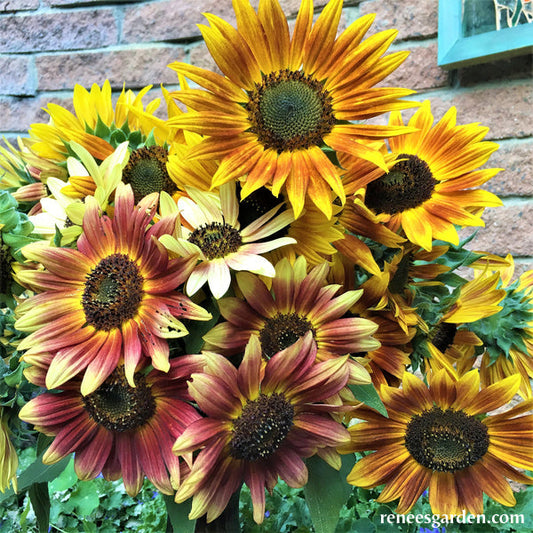





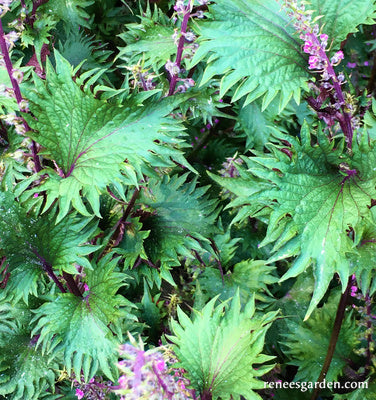






 See Full Description
See Full Description
